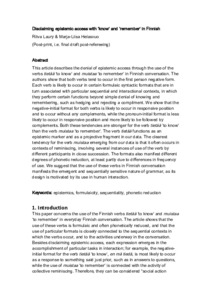Disclaiming epistemic access with ‘know’ and ‘remember’ in Finnish
Marja-Liisa Helasvuo; Ritva Laury
https://urn.fi/URN:NBN:fi-fe2021042715736
Tiivistelmä
This
article describes the denial of epistemic access through the use of the verbs tietää ‘to know’ and muistaa ‘to remember’ in Finnish
conversation. The authors show that both verbs tend to occur in the first
person negative form. Each verb is likely to occur in certain formulaic
syntactic formats that are in turn associated with particular sequential and
interactional contexts, in which they perform certain functions beyond simple
denial of knowing and remembering, such as hedging and rejecting a compliment. We
show that the negative-initial format for both verbs is likely to occur in
responsive position and to occur without any complements, while the
pronoun-initial format is less likely to occur in responsive position and more
likely to be followed by complements. Both these tendencies are stronger for
the verb tietää ‘to know’ than the
verb muistaa ‘to remember’. The verb tietää functions as an epistemic marker
and as a projective fragment in our data. The clearest tendency for the verb muistaa emerging from our data is that
it often occurs in contexts of reminiscing, involving several instances of use
of the verb by different participants in close succession. The formats also manifest different degrees of phonetic reduction,
at least partly due to differences in frequency of use. We suggest that the use
of these verbs in Finnish conversation manifests the emergent and sequentially
sensitive nature of grammar, as its design is motivated by its use in human
interaction.
Kokoelmat
- Rinnakkaistallenteet [19207]
